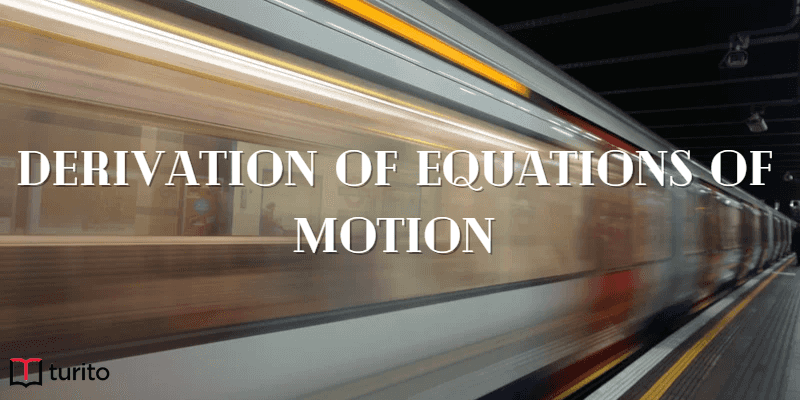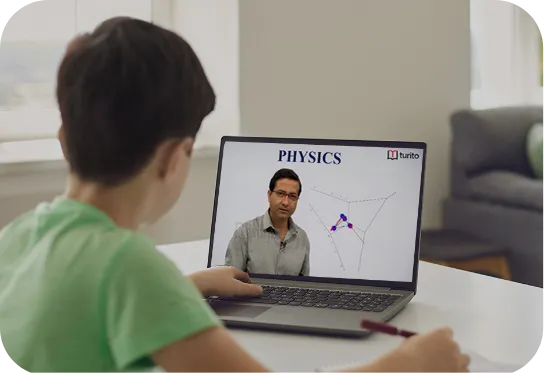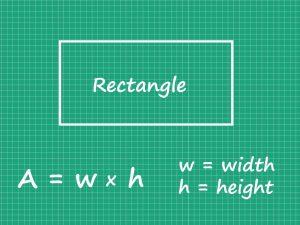Introduction:
In a uniformly accelerated motion in a straight line, the velocity of the body increases or decreases by equal amounts in equal intervals of time. For such kinds of motion, the various attributes of motion such as the displacement, velocity, and acceleration for a certain time interval can be related by a set of equations. This set of equations is called the equations of motion. One or two unknown quantities can be calculated by using the equations of motion if other quantities are known.
Explanation:
Equations of Motion:
Let us consider the following physical quantities by the symbols given below for a body in a uniformly accelerated/ decelerated motion.
- Initial velocity = u
- Final velocity = v
- Acceleration = a
- Time = t
- Displacement = s
The equations of motion connecting the above-mentioned physical quantities are as follows:
v = u + at
s = ut + at2
v2 = u2 + 2as
Derivation:
All the equations of motion can be derived from the V-t graph. Consider the V-t graph of a body in a uniformly accelerated motion shown below. The v-t graph (AC) represents the motion of a body in a uniformly accelerated motion with a non-zero initial velocity. The constructions CD (perpendicular to the x-axis) and AB (perpendicular to CD) are drawn. Now, OACD forms a trapezium which is made of a triangle ACB and a rectangle OABD.

The above v-t graph represents the motion of a body with a non-zero initial velocity u (given by the length AO of the graph). The body increases its velocity to v (given by the length CD) in time t (given by the length OD). Let s be the displacement of the body in time t, and the velocity changes at a uniform rate a.
The First Equation of Motion:
From the graph, it is seen that,
CD = CB + BD
= CB + OA (as OABD is a rectangle)
Or, CB = CD – OA
CB = v – u ——- (1)
Now, the acceleration is given by,
a = ——- (2)
Here, the change in velocity is given by v – u, which is CB in time t.
Therefore, a =
Or, CB = at ——- (3)
Inserting equation (3) into equation (1) we get,
v – u = at
This is the first equation of motion. It is also called the velocity-time relation.
Problems:
- A car starts from rest and acquires a velocity of 20 m/s in 4 seconds. Find its acceleration.
Solution:
Given that,
The initial velocity, u = 0
The final velocity, v = 20 m/s
Time taken, t = 4 s
On using the first equation of motion we get,
v = u + at
Or, a = (v – u)/t
Or, a = (20 – 0)/4
Or, a = 20 / 4
Or, a = 5 m/s2
Therefore, the acceleration of the car is 5 m/s2.
2. A vehicle moving at a speed of 5 m/s accelerates at a rate of 3 m/s2 for 25 seconds. Calculate the final velocity of the vehicle.
Solution:
Given that,
The initial velocity, u = 5 m/s
The acceleration, a = 3 m/s2
Time taken, t = 25 s
On using the first equation of motion we get,
v = u + at
Or, v = 5 + 3 × 25
Or, v = 5 + 75
Or, v = 80 m/s
Therefore, the final velocity of the vehicle is 80 m/s.
3. An athlete starts running and keeps increasing his speed by 0.5 m/s every second. What is the final speed that he reaches after 24 seconds? What distance does he cover meanwhile?
Solution:
Given that,
The initial velocity, u = 0
The acceleration, a = 0.5 m/s2
Time taken, t = 24 s
On using the first equation of motion we get,
v = u + at
Or, v = 0 + 0.5 x 24
Or, v = 12 m/s
Therefore, the final velocity of the athlete is 12 m/s.
On using the second equation of motion we get,
s = ut + at2
Or, s = 0 + (0.5) (24)2
Or, s = 144 m
Therefore, the distance covered by the athlete is 144 m.
4. The driver of a car moving at a speed of 25 m/s applies the brakes on seeing a cat crossing the road at some distance. The car stops after 10 s. What is the acceleration of the car? How far did it go after the brakes were applied?
Solution:
Given that,
The initial velocity, u = 25 m/s
The final velocity, v = 0
Time taken, t = 10 s
On using the first equation of motion we get,
v = u + at
Or, a = (v – u)/t
Or, a = (0 – 25)/10
Or, a = – 25 / 10
Or, a = – 2.5 m/s2
Therefore, the acceleration of the car is – 2.5 m/s2.
On using the second equation of motion we get,
s = ut + at2
Or, s = 25 × 10 + (– 2.5) (10)2
Or, s = 250 – 125
Or, s = 125 m
Therefore, the distance covered by the car is 125 m.
5. A ball is thrown upwards with a speed of 32 m/s. How high would the ball reach? How long would the ball take to reach the maximum height?
Solution:
Given that,
The initial velocity, u = 32 m/s
The final velocity, v = 0
The acceleration, a = g = 9.8 m/s2
At the maximum height, the velocity of the ball becomes zero.
On using the first equation of motion we get,
v = u + at
Or, 0 = 32 + 9.8 × t
Or, t = 32 / 9.8
Or, t = 3.265 s
Therefore, the time taken by the ball to reach the maximum height is 3.265 s.
On using the second equation of motion we get,
s = ut + at2
Or, s = 32 x 3.265 + (9.8) (3.265)2
Or, s = 104.48 – 52.235
Or, s = 52.245 m
Therefore, the maximum distance covered by the ball is 52.245 m.

Related topics
Different Types of Waves and Their Examples
Introduction: We can’t directly observe many waves like light waves and sound waves. The mechanical waves on a rope, waves on the surface of the water, and a slinky are visible to us. So, these mechanical waves can serve as a model to understand the wave phenomenon. Explanation: Types of Waves: Fig:1 Types of waves […]
Read More >>Dispersion of Light and the Formation of Rainbow
Introduction: Visible Light: Visible light from the Sun comes to Earth as white light traveling through space in the form of waves. Visible light contains a mixture of wavelengths that the human eye can detect. Visible light has wavelengths between 0.7 and 0.4 millionths of a meter. The different colors you see are electromagnetic waves […]
Read More >>Force: Balanced and Unbalanced Forces
Introduction: In a tug of war, the one applying more force wins the game. In this session, we will calculate this force that makes one team win and one team lose. We will learn about it in terms of balanced force and unbalanced force. Explanation: Force Force is an external effort that may move a […]
Read More >>Magnets: Uses, Materials, and Their Interactions
Introduction: Nowadays magnets are widely used for many applications. In this session, we will discuss the basics of magnets and their properties, and the way they were and are used. Explanation: Magnets: Magnetic and Non-magnetic Materials: Poles of a Magnet: Fig No. 1.2: Poles of a magnet Compass: Interaction Between Magnets: The north pole of […]
Read More >>Other topics







Comments: